Emilio Artacho

Prof Emilio Artacho
Professor of Theoretical Mineral Physics
Fellow of Clare Hall
Office: 520 Mott Bld
Phone: +44(0)1223 3 37461
Email: ea245 @ cam.ac.uk
Personal web site
ORCID: 0000-0001-9357-1547
TCM Group, Cavendish Laboratory
19 JJ Thomson Avenue,
Cambridge, CB3 0HE UK.
Research Group
- Dr Marjan Famili
- Danny Bennett
- Shiyu Deng
- Jessica Halliday
- Jessica Halliday (CDT)
- Adiran Garaizar (MPhil) Dr. Eleanor Green (ETH Zurich)
- Dr. Etienne Plessiat (Nanogune)
- Jon Zubeltzu (Nanogune, Spain)
- Rafi Ullah (Nanogune, Spain)

Research
We work within the field of computational and theoretical condensed matter physics, especially (but not exclusively) developing and using first-principles simulation methods. Recent work include the study of nano-confined water in 2D, within a longer line of work in the study of liquid water. The figure shows a proposed phase diagram for water confined to a slab of around 1 nm thickness, showing interesting new proposed phases at high density, including a hexatic phase [J. Zubeltzu et al, Phys. Rev. E (2016)]. This and similar studies are based on molecular dynamics simulations, both from first principles and using empirical potentials. For the former we use the Siesta linear-scaling DFT method, which we developed and maintain in collaboration with other groups.
Another defining research line of the group is the study of non-adiabatic processes in forced electronic systems, mostly as affected by an ion projectile shooting through them, as happens in radiation-damage processes. For this purpose we use real-time time-dependent DFT.
Other topics are researched within the group responding to interesting collaborations with other groups. These include the study of complex and functional oxides and their heterostructures, isotopic fractionation of water in hydrous minerals of interest for Martian geochemistry, the electronic properties of a recent family of superconductors based on bismuth sulphide, and shock waves from first principles.
More details on my background can be found here.

In Plain English
The physics of low-energy matter (of temperatures below a few million degrees centigrade) is extremely well described by considering electrons and atomic nuclei attracting and repelling each other as point charges, and moving about following the laws of quantum mechanics. So far this theory has been systematically proven right. It allows, in principle, the theoretical predition of the properties of any such matter, from materials for batteries or the interior of planets to DNA. The resolution of that theory's equations is of enormous complexity, however, when the system to be studied consists of many particles. A substantial amount of research in the last century has been dedicated to find efficient (albeit approximate) quantum simulation methods, enabling us to predict low-energy-matter properties using computers.
We have contributed to that effort with the development of what is called a linear-scaling density-functional theory method (a very efficient one), called Siesta, and we still work developing new efficient ways of computing properties of interest for systems of interest. The systems that are of interest to us at the moment are varied. They include liquid water confined to nanoscale dimensions (1 nanometer is a millionth of a milimeter), as found in living cells and in rocks of the soil. If normal (not confined) liquid water is already fascinating at the atomic scale, the nanoconfined counterpart is quite astonoshing in its behaviour. It is becoming increasingly clear that its properties are important in the working of the machinery of cells in living beings. We also work on the study of radiation damage in matter, from the materials needed to encapsulate nuclear waste (the one we already have) in a safe way for the required time (around one hundred thousand years), to the effect of radiation on living tissue for the understanding and improvement of ion radiotherapy.
Featured Publications
- Quantum mechanics for an evolving Hilbert space. arXiv:1608.05300v1
- Enhanced residual entropy in high-density nanoconfined bilayer ice. Phys. Rev. Lett. 116 085901 (2016)
- Room temperature compressibility and diffusivity of liquid water from first principles. J. Chem. Phys. 139 194502 (2013)
- Electronic stopping power in gold: the role of d electrons and the H/He anomaly. Phys. Rev. Lett. 108 225504 (2012)
- Nonadiabatic forces in ion-solid interactions: the initial stages of radiation damage. Phys. Rev. Lett. 108 213201 (2012)
- Proposal of a one-dimensional electron gas in the steps at the LaAlO3-SrTiO3 interface. Phys. Rev. Lett. 108 166802 (2012)
- Transformation of spin information into large electrical signals using carbon nanotubes. Nature 445 410 - 413 (2007)